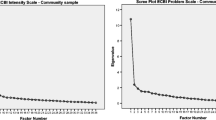Abstract
The reliability, factor structure, and validity of the Behavior Problem Inventory (BPI) Rojahn, 1984, 1986) was examined in an independent replication sample. The BPI showed good reliability. A factor analysis revealed two factors corresponding to internalizing and externalizing behavior disorders. Factor analysis of self-injury items replicated two of the three factors reported by Rojahn (1991). Finally, good to modest validity was found between the BPI scales and the Aberrant Behavior Checklist, and use of psychotropic medication and behavior therapy.
Similar content being viewed by others
References
Aman, M. G. (1991).Assessing psychopathology and behavior problems in persons with mental retardation: A review of available measures, U. S. Department of Health and Human Services, Rockville, MD.
Aman, M. G., Singh, N. N., Stewart, A. W., and Field, C. J. (1985a). The Aberrant Behavior Checklist: A behavior rating scale for assessment of treatment effects.Am. J. Ment. Def. 89: 485–491.
Aman, M. G., Singh, N. N., Stewart, A. W., and Field, C. J. (1985b). Psychometric characteristics of the Aberrant Behavior Checklist.Am. J. Ment. Def. 89: 492–502.
Cohen, J. (1960). A coefficient of agreement for nominal scales.Ed. Psychological Meas. 20: 37–46.
Newton, T., and Sturmey, P. (1988). The factor structure of the Aberrant Behavior Checklist: A British replication.J. Ment. Def. Res., 32: 87–92.
Nie, N. H., Hull, C. H., Jenkins, J. G., Steinbrenner, K., and Brent, D. H. (1975).Statistical Package for the Social Sciences, McGraw-Hill, New York.
Nihira, K. (1969). Factorial dimensions of adaptive behavior in adult retardates.Child. Adol. Am. J. Ment. Def., 73: 868–878.
Rojahn, J. (1984). Self-injurious behavior in institutionalized, severely/profoundly retarded adults—prevalence and staff agreement.J. Behav. Assess. 6: 13–27.
Rojahn, J. (1986). Self injurious and stereotypic behavior of noninstitutionalized mentally retarded people: prevalence and classification.Am. J. Ment. Def. 91: 268–276.
Rojahn, J. (1991). Epidemiology and topographic taxonomy of self-injurious behavior. Paper presented to Conference on Destructive Behavior in Developmental Disabilities: Diagnosis, Measurement and Evaluating Treatment Outcomes. Minneapolis, MN, April 10–12, 1991.
Rojahn, J., Polster, L. M., Mulick, J. A., and Wisniewski, J. J. (1989). Reliability of the Behavior Problem Inventory.J. Multihand. Per., 2: 283–293.
Sturmey, P. (in press). Behavior assessments of older adults: A review of factor analytic studies and a proposed model.Int. J. Geriat. Psychiatry.
Sturmey, P., and Ley, T. (1990). The Psychopathology Instrument for Mentally Retarded Adults: Internal consistencies and relationship to behavior problems.Brit. J. Psychiatry 156: 428–430.
Author information
Authors and Affiliations
Rights and permissions
About this article
Cite this article
Sturmey, P., Fink, C. & Sevin, J.A. The behavior problem inventory: A replication and extention of its psychometric properties. J Dev Phys Disabil 5, 327–336 (1993). https://doi.org/10.1007/BF01046389
Issue Date:
DOI: https://doi.org/10.1007/BF01046389




